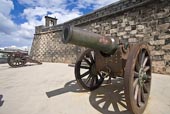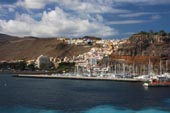Canary Islands History
Learn about Canary Islands history by reading this interesting article.



Brief History of the Canary Islands
Canary Islands History
The Canary Islands - The Early Days: Amongst the most popular winter holiday destinations, the Canary Islands form an archipelago of 7 major islands and several islets, all situated in the Atlantic Ocean off the coast of northwest Africa. The island group in total has a land area of 7,447 square kilometres and a population of just under 2 million.
The main islands are Tenerife, Gran Canaria, Lanzarote, La Palma, Fuerteventura, La Gomera and El Hierro, the largest being Tenerife and the smallest, El Hierro, the title of capital city of the group is actually shared between Santa Cruz de Tenerife and Las Palmas de Gran Canaria.
The Canary Islands were formed about 30 million years ago as huge slabs of the Earth’s crust collided, forcing folds upwards from the ocean floor in the form of mountains and volcanoes, subsequent volcanic eruptions moulded them into their current shapes. Volcanic activity still takes place not far below the surface as can be seen at Lanzarote’s Timanfaya National Park, where water poured into hollow pipes returns to the surface as steam in just a few seconds, and brushwood is transformed into balls of flames. Each island has its own distinctive features and we shall visit each in turn to discover their particular attributes.
The name Islas Canarias (Canary Islands) is probably derived from the Latin for “Island of Dogs” (Insular Canaria), referring to the numerous wild dogs which were endemic on the islands when the Romans first landed there. The dogs were large and fierce and obviously made quite an impression on these new visitors.
The Romans, however, were not the first to arrive on the islands and the history of the Canaries is shrouded in myth and legend, some believing that there were actually part of the lost land of Atlantis. The first inhabitants probably arrived in around 3,000 BC and came from the north-east of Africa. The first to establish real settlements were known as the Guanches, who came to the islands during the 2nd century BC. The Guanches (‘guan’ = man, ‘che’ = white mountain) were a tall, blond blue-eyed race of humans, whose origins are still unknown, their society consisted of a tribal structure with a king at its head, they used weapons and tools, lived in caves and later primitive, low, stone dwellings.
So it was the Guanches who the Romans first encountered in around 40 BC, as an expedition by Juba II arrived in what were then known as The Fortunate Islands. In AD 150, geographer Ptolemy created a reasonably accurate map of the islands and represented them as the edge of the world. As the Roman Empire fell into decline, the Canary Islands were forgotten for over 1,000 years and there is almost no written records of them before the 14th century.
It was at the start of the 14th century that a Genoese captain named Lanzarotto encountered what is now called Lanzarote, word spread and various Italian and Portuguese expeditions explored and mapped the islands, bringing them to the attention of European nations.
The conquest of the Canary Islands began in 1402 as a Norman Knight Jean de Bethencourt landed on Lanzarote with a small ill-equipped force, Bethencourt went on to establish a fort on the island of Fuerteventura, but soon ran out of supplies and headed for Spain in an attempt to get the backing of the Castillian crown.
The next article will look at the later history of the Canary Islands.
Canary Islands Links: Canary Islands Guide
Related: Fuerteventura - Tenerife - Gran Canaria - La Palma - Lanzarote - La Gomera - Spain - Builders
HOME
